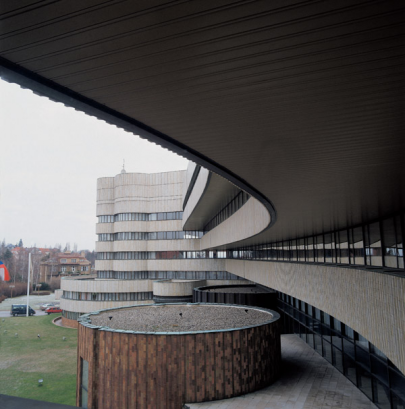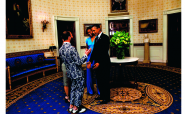| Umělec 2000/3 >> Hotel Praha | Просмотр всех номеров | ||||||||||||
|
|||||||||||||
Hotel PrahaUmělec 2000/301.03.2000 Tomáš Lahoda | architecture | en cs |
|||||||||||||
|
Everybody from time to time encounters something that could qualify as “ugly” in a peculiar way, and yet it remains persistently fascinating and paradoxically attractive. Such feelings strike you immediately upon entering the semicircular staircase descending under the colossal circle-cluster of shining glass stalactites in the lobby of Hotel Praha.
“Sometimes something can look beautiful just because it’s different in some way from the other things around it. One red petunia in a window box will look very beautiful if all the rest of them are white, and vice-versa. When you are in Sweden and you see beautiful person after beautiful person after beautiful person and you finally don’t even turn around to look because you know the next person you see will be just as beautiful as the one you didn’t bother to turn around to look at—in a place like that you can get so bored that when you see a person who’s not beautiful, they look very beautiful because they break the beautiful monotony.” With these words and the hand gesture of the porcelain sculpture of John the Baptist by Jeff Koons, pointing upward, American artist Louise Mot welcomes me in the lobby as I meet her on her way from Vienna to Sao Paulo to show her around Prague, the European cultural capital 2000. “Free countries are great, because you can actually sit in somebody else’s space for a while and pretend you are a part of it. You can sit in the Plaza Hotel, and you don’t even have to live there. You can just sit and watch the people go by,” she contemplates in true Warhol style and invites me to sit down in an oversized brown leather chair in the foyer of this five-star equivalent—Hotel Praha. As it turned out, the most cultural thing to do was to just stay in the hotel and become a part of it for a while and simply look around. Hotel Praha was built in the 1970s by a team of architects (A. Navrátil, Paroubek, R. Černý) on the slope of the Hanspaulka villa neighborhood. It was meant to be a luxury party hotel for the ruling elite and their visitors from abroad, and occasionally substituted for by wealthy VIPs from the opposing camp, those who could afford to stay there. The wavy, echelon-like corpus of the hotel, encased in white, molded tiles, looks like it was cut out from the seaside, from a south-sea tourist paradise. It was opened in 1980, showing off the opulent style of the late 1960s and 1970s, reminding you of the futuristic architecture of early sci-fi movies. Applied circles and semicircles and design work rendered in excruciating detail, sophisticated interiors and furnishings characterize the entire building design. The embossed, wavy paneling and brown leather upholstery of the diversely-shaped chairs dominate most of the space in this slightly pompous, official-looking, yet high-flown in color and form, tame version of 1970s style. In some parts the original furnishing has been replaced (chairs and tables in restaurants) while elsewhere later accessories of different styles were added (the entrance lobby). What is not missing, however, are the obligatory, painful exhibitions in the hallways and the temporary seasonal decorations. The chandeliers have been assailed by those hideous “economy” bulbs. Otherwise, the interior has remained basically preserved in its original appearance. The clearly limitless inflow of funds is reflected here in the integral rendition of the entire project’s concept, and ostentatiously evokes an air of respectability in a modern environment. The effects of the execution of the design are ubiquitous. Notice everything from the door handles and toilet signs, built-in holders for billiard sticks with meters, white iron deckchairs on balconies to the circular, audio-video equipped conference and projection room. An array of massive ceiling chandeliers looking like exuberant, frozen ice geysers of star-shaped fireworks and clusters of glass-lit bubbles and stalactites in a number of variations contrast with the clean shapes of desktop lamps, which combine milk-colored glass and coppery metal, a design concept in rooms and suits reminiscent of the late 1960s and early 1970s. One of the surprising revelations in this gigantic complex includes the leisure and sports facilities. Would you care to take a dip in the pool, refresh yourself in the sauna, gamble in the casino, have a tennis match or stroll through the hotel park? The elegant, snail-shaped swimming pool is closed in by light-colored shaped tiles with mat glass doors and decorative, semi-transparent glass walls. Lightness and airiness in shape and color is tempered by the heavy brown of the wood-cased, embossed columns placed in front of the wavy glass wall running from floor to ceiling and the view of the Castle. Louise Mot rightly said of the casino and bar, pool tables and bowling that it was “… a hybrid of a swank rustic cabin and a bowling alley in Las Vegas.” The extensive hotel park on the slope below the hotel’s balconies houses tennis courts, a futuristic, triangle construction of the winter garden with tropical flora and a self-supply of flowers, and a modernist villa for the biggest celebrities tucked away in the corner. In the past, Czechoslovak communist president Husák would meet East German leader Honecker, and the ex-Soviet Foreign Secretary Shevarnadze here. Today the hotel accommodates national soccer, and handball teams among others, rock bands such as Manowar, singers like Drupi, monks of the Shaolin sect, the Japanese prince Naruhito, the javelin thrower Železný, Louise Mot and me for a day.
01.03.2000
Рекомендуемые статьи
|
|||||||||||||















Комментарии
Статья не была прокомментированаДобавить новый комментарий